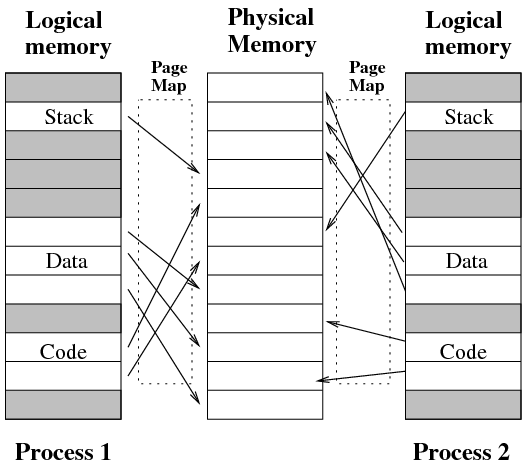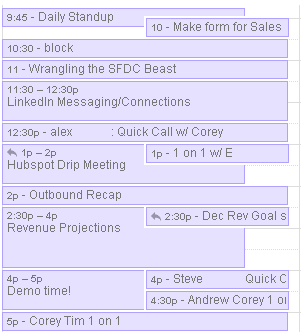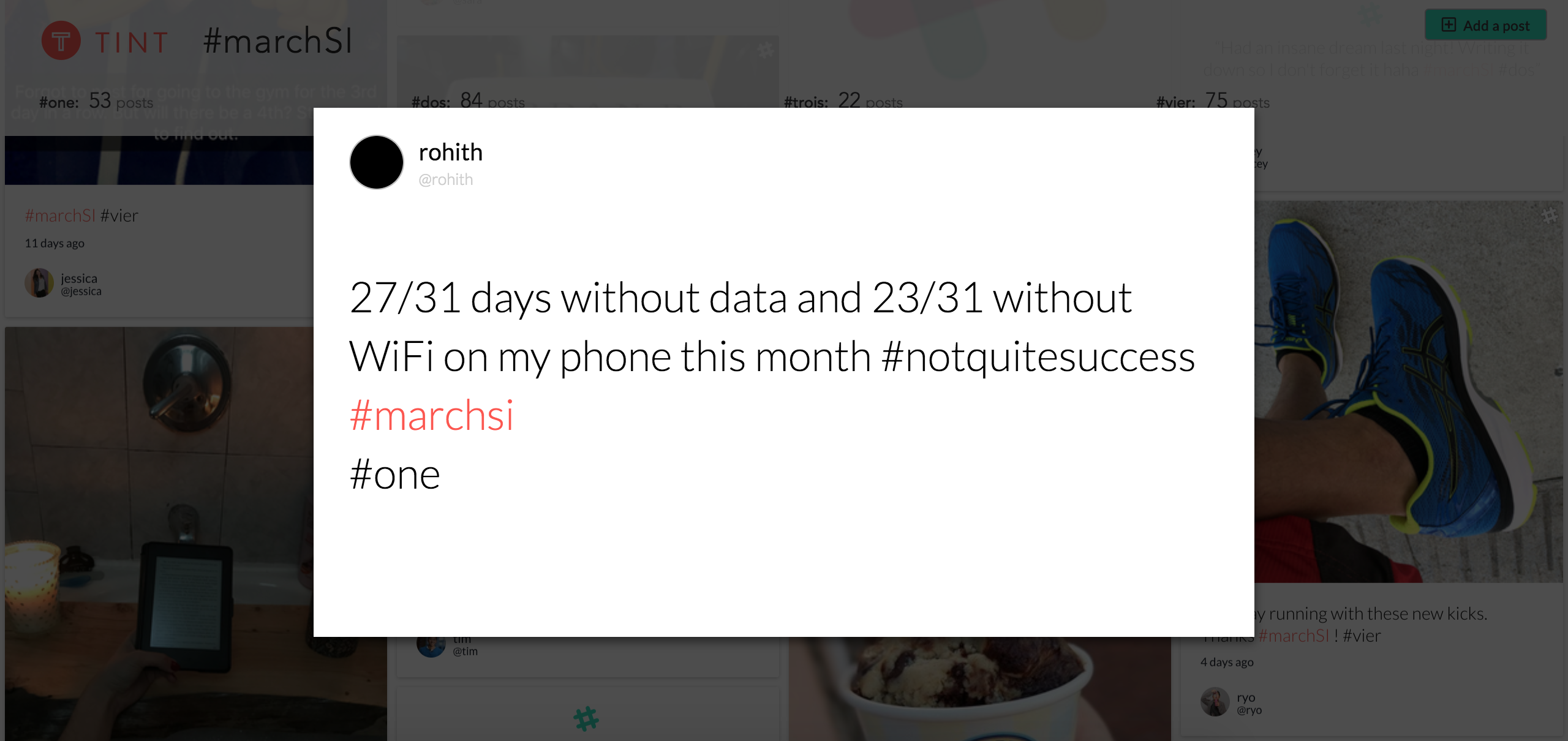When I started at TINT a year ago, my job description was simple in nature: to lead the sales and customer success teams. This was nothing different than what my previous positions had been and I welcomed the challenge of a new, fresh company. TINT was profitable, there was a foundation of success, and the culture made TINT a fantastic work environment. The one challenge I did not foresee, and the one that led to my greatest moments of inefficiency, was how many disparate responsibilities I would have in this role.
I reached a point mid-summer 2015 where my responsibilities as a team lead were being affected by my inclusion in so many projects. I was working more hours, spending more time doing different things, but getting less done. On top of that, many of my lower priority tasks (operational changes in our CRM, weekly training sessions, data auditing) were being pushed further and further back. On top of that, I was so busy with different initiatives that I couldn’t realize what had happened to my time management. It took my fellow TINTers pointing this out for me to re-align my schedule.
TINT really is one of those rare startups where you can continue to push the pedal down on many fronts. Our team is successful and inclusive. We do a great job of communicating and being transparent, but this can lead to longer processes.
An exciting part of being an “older” (I’m only 32!) San Francisco startup employee is that I have a fair amount of experience to offer. I’ve been with companies that have gone IPO, companies who have gone through large fundraising rounds, and companies that have failed. This usually means I am asked to participate in a large portion of decision-making at TINT. This is a great exercise professionally and invaluable to my company, but it can lead to my core tasks being neglected. I become more burdened with the decision making process, my day-to-day priorities begin to slip, and I end up with changing context constantly in my days.
Context Switching

Context switching is a term many of us live with in our professional lives. Originally from computing, it is the state of storing a current thread or dataset to be re-introduced later from that same state (see the complexity above). Unfortunately for us, human beings aren’t as binary as a computer. We are often required to context switch in our workdays. Going from a team meeting to a sales call, then jumping in a 1 on 1 with a peer, hopping back on another sales call, having to respond to three time-sensitive emails, etc. The amount of responsibilities, notifications, tasks, and emails that a typical professional has to deal with on a daily basis can be overwhelming. Just take a look at a typical day in my “old” schedule.

In one day I had:
4 ops/admin tasks
1 interview
2 meetings
2 1 on 1s
2 sales calls
1 block for sales outreach
1 team product demo
Where the Crux Kicks In
In order to be successful in any role, you have to manage your time effectively. This is especially true when you are managing people. There will undoubtedly be pressure from above to meet business goals. There will also be needs from your peers and employees to help remove blockers, enable them to function efficiently, grow professionally, accomplish their day-to-day tasks, etc. High level business decisions inherently require high prioritization, but there has to be room for day-to-day responsibilities and tasks.
Prioritization v1 – Blocking Hours
My first attempt at solving this came from advice I give to everyone: Put your calendars in blocks and make a concrete schedule. Each block you set designates time to accomplish a specific task. You are holding yourself (and your co-workers) accountable for that task. This has historically worked well for me, but I quickly discovered that I had simply too many items bleeding into each day and was right back where I started: switching context far too often, being distracted by too many action items and working inefficiently.
Prioritization v2 – (So) Meta Blocking
I wanted something more complete and effective at combining similar tasks and responsibilities. The goal was to organize my tasks into more clearly defined blocks that kept me in the same mind-set throughout the day. I began tracking and curating hours along with volume of tasks I was accomplishing on a weekly basis. I set out to compile my days into 5 buckets. Instead of solving my context switching on an hour-by-hour basis, I planned on blocking each day off for a similar set of tasks/responsibilities. I was able to minimize distractions while maintaining a similar attitude about my work behavior for the day. My schedule broke down like this:
Monday – Team Meetings/Planning/Project Kickoffs
Tuesday – Admin/Ops/Tasks
Wednesday – Training/1 on 1s/Research
Thursday – Metrics/Sales/Check-ins
Friday – Sales Calls/Customer Success/Hackdays/Free!
When bringing this up to my CEO, he said he had read that Jack Dorsey of Twitter does something similar with his schedule. Great! Validation! The hardest part of compiling this schedule was maintaining productivity for each facet of my work responsibilities and giving enough time to each. I didn’t want to come in on a Thursday and have nothing to do when my Mondays were hectic. With some tweaking, I have settled into a very successful schedule. Here are my findings so far.
State of the Schedule
I have been using this scheduling method for the last month. I was very transparent and insistent to my team that I was experimenting with my schedule and to follow my schedule for planning meetings/etc. I wanted to be flexible with other teammates and not affect their productivity but wanted people to adhere to my schedule if it didn’t affect theirs.
The first and most exciting change was that I felt like I had more time. If I had a meeting, an ops task, something to audit, metrics to compile, I wasn’t just trying to shove it into the next available calendar spot. I actually had a day and time that I knew where it belonged. My calendar stopped being so today-loaded and started spreading out in a more manageable way. Sure, my days still get clogged up, but they do so on a weekly basis, not daily.
The second change I noticed was that I was able to switch between two tasks more efficiently on specific days. My Tuesdays fly by because they are all administrative/operational tasks. I am making edits to our CRM, compiling reports, fixing bugs, auditing data, etc. I know going into that day that I should be data focused. On Wednesdays, I have all of my 1 on 1s schedule and am prepared beforehand to provide and receive insight, advice, etc.
The third change was that I was no longer saying Yes to everything. Part of my impetus for creating this schedule was to get better at saying No to things that I shouldn’t be prioritizing. As much as I want to have input into everything I can and love that my co-workers trust me to help with decision making, it was getting in the way of my more important tasks. This schedule made me think critically about where a request would fit on my calendar and made me more aware of what things didn’t fit into my priorities.

No More Context Switching: Keeping the Schedule
This experiment has turned into a game changer for me. I was able to take a look at the chaos that was my day-to-day work and organize it in a tangible manner that affected both my happiness and my productivity. I am a big stickler for efficiency. Before I started this experiment, I could feel myself becoming less and less efficient as I dove into more and more projects. One of my favorite ways to explain this decay in efficiency is this: 100% focus from an intelligent contributor is incredibly valuable. 20% of their focus isn’t worth that much. I give this advice all the time with my peers, but it took me a while to realize I was doing this to myself. I had spread myself too thin across too chaotic of a medium to make the impact I knew I could make. With a proactive adjustment, I can now see my weeks ahead of time, prepare for them more efficiently, and keep my brain from constantly being caught in the shuffle of Context Switching.




